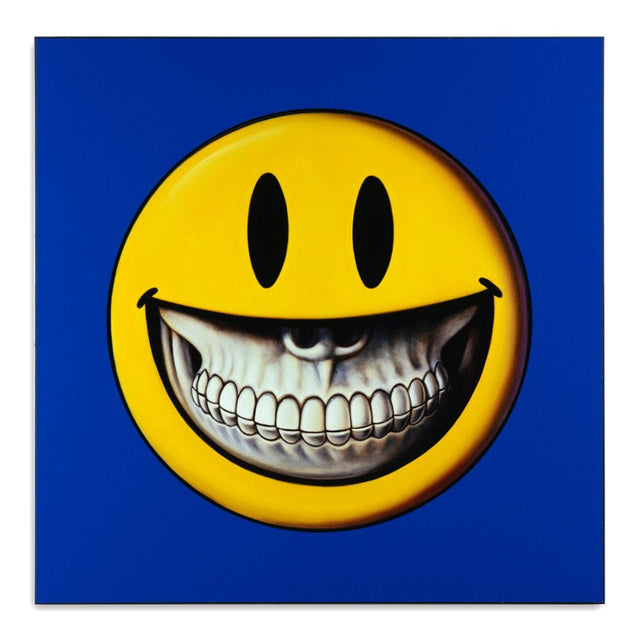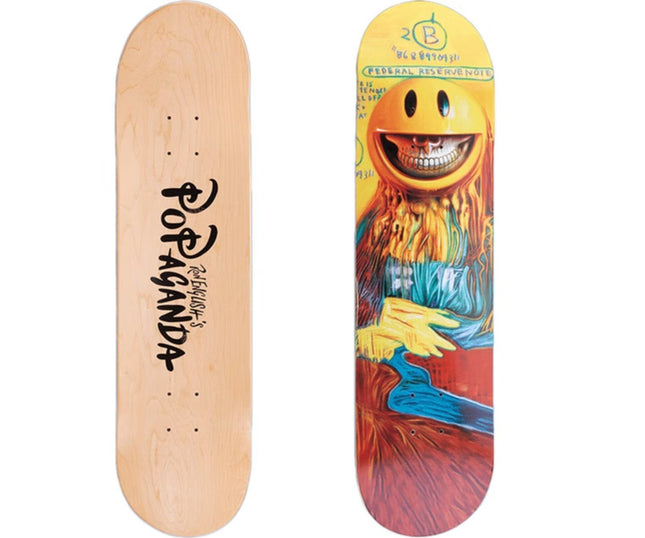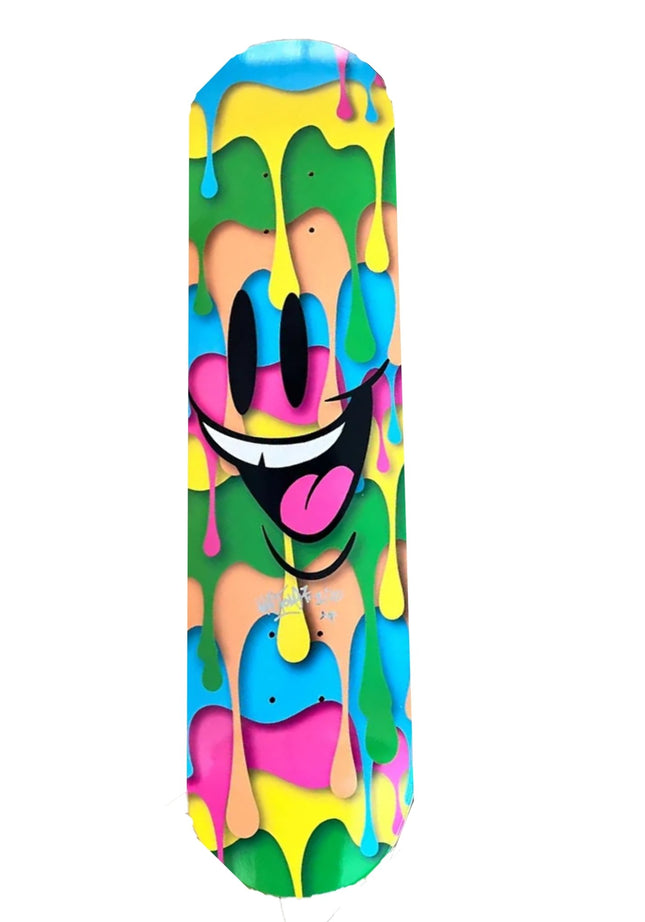
Smiley Face
-

Ron English- POPaganda Mona Lisa Grin Funko Shop Deck Archival Skateboard by Ron English- POPaganda
Mona Lisa Grin Funko Shop Exclusive Deck Fine Art Limited Edition Archival Pigment Print Transfer on Natural Skateboard Deck by Graffiti Artist Ron English- POPaganda. 2020 Limited Edition of 300
$240.00
-

Sket-One Drip Phase Artist Proof Deck Archival Print AP Skateboard by Sket-One
Drip Phase Artist Proof Deck Fine Art Limited Edition Archival Pigment Print Transfer on Cold Pressed Steep Natural Skateboard Deck by Street Artwork Graffiti Artist Sket-One. AP Artist Proof Signed 2022 Edition of 20
$381.00
-

OG Slick Happy Endings Skateboard Art Deck by OG Slick x The Beautiful Losers
Happy Endings Skateboard Art Deck by OG Slick x The Beautiful Losers Limited Edition Print From Artist on Wood Pop Street Graffiti Sports Object Artwork. 2024 Limited Edition of 99 Sports Artwork Skateboard Size 8x31 Skateboard Art Deck Printed Art Object Smiley Face with Hand Spray Painting a Line Across The Face. Happy Endings Skateboard Art Deck: A Bold Fusion of Street Pop Art and Graffiti Culture The Happy Endings Skateboard Art Deck by OG Slick, created in collaboration with The Beautiful Losers, is a striking example of Street Pop Art and Graffiti Artwork. Released in 2024 as a limited edition of 99, this 8x31-inch skateboard deck transforms a functional object into a bold statement of urban art. Featuring OG Slick’s iconic Smiley Face motif, disrupted by a red spray-painted line across the eyes, the design evokes a thought-provoking blend of playfulness and rebellion. The incorporation of a gloved hand holding a spray paint can adds depth and narrative, making this piece as much about the act of creation as the final result. OG Slick and the Subversive Vision of Happy Endings OG Slick, a renowned artist with roots in graffiti culture, has built a career on merging pop culture symbols with the raw energy of street art. The Happy Endings Skateboard Art Deck embodies his signature aesthetic, using the universally recognized Smiley Face as a canvas for a commentary on perception and identity. The addition of the red spray-painted line across the face disrupts the familiar image, inviting viewers to reconsider their interpretations of happiness and conformity. By partnering with The Beautiful Losers, a collective known for celebrating the intersection of street culture and fine art, this collaboration elevates the piece to a broader cultural conversation. Design and Symbolism of the Skateboard Deck The minimal yet impactful design of the Happy Endings Skateboard Art Deck is a testament to OG Slick’s ability to convey powerful messages through simplicity. The bright yellow background serves as a stark contrast to the bold black and red elements, drawing immediate attention to the central Smiley Face. The red line, sprayed across the eyes, symbolizes censorship, disruption, or the act of redefining societal norms. The gloved hand at the bottom holding a spray paint can captures the essence of graffiti culture, emphasizing the artist’s role in reshaping familiar images. The skateboard’s shape and size provide a unique medium that blends the functionality of sports equipment with the storytelling potential of art. Functional Art for Collectors and Enthusiasts The Happy Endings Skateboard Art Deck is more than just a piece of sports equipment; it is a collectible artwork that embodies the rebellious spirit of Street Pop Art and Graffiti Artwork. Crafted from high-quality wood and printed with precision, the deck is designed to be both durable for use and visually striking for display. With only 99 pieces in this signed and numbered edition, the deck holds significant value for art collectors and street art enthusiasts alike. This collaboration between OG Slick and The Beautiful Losers transforms a simple object into a cultural artifact, highlighting the evolving role of street art in contemporary creative expression.
$325.00
-

OG Slick Big Slick Aloha Skateboard Art Deck by OG Slick x The Beautiful Losers
Big Slick Aloha Skateboard Art Deck by OG Slick x The Beautiful Losers Limited Edition Print From Artist on Wood Pop Street Graffiti Sports Object Artwork. 2024 Limited Edition of 99 Sports Artwork Skateboard Size 8x31 Skateboard Art Deck Printed Art Object Smiley Face with Hands Spray Painting a Hawaiian Flower. Big Slick Aloha Skateboard Art Deck: A Dynamic Fusion of Hawaiian Culture and Street Art The Big Slick Aloha Skateboard Art Deck by OG Slick in collaboration with The Beautiful Losers is a bold and captivating piece that merges Hawaiian cultural motifs with the energy of Street Pop Art and Graffiti Artwork. Released in 2024 as a limited edition of 99, this 8x31-inch skateboard deck transforms a functional sports object into a statement of urban artistry. Featuring OG Slick’s signature Smiley Face motif combined with hands spray-painting a vibrant Hawaiian flower, this deck embodies a playful yet deeply symbolic fusion of graffiti culture and island-inspired design. OG Slick’s Vision of Hawaiian Street Pop Art OG Slick, an artist originally from Hawaii, is known for his ability to bridge urban art forms with the cultural identity of the islands. In the Big Slick Aloha Skateboard Art Deck, Slick brings his unique style to life through his iconic Smiley Face design, reimagined with Hawaiian influences. The addition of hands spray-painting a hibiscus flower—a symbol of the islands' beauty and resilience—adds depth and meaning to the work. By collaborating with The Beautiful Losers, a collective that champions the intersection of contemporary street culture and fine art, Slick expands the reach of Hawaiian aesthetics to an international audience. Design and Symbolism of the Big Slick Aloha Deck The design of the Big Slick Aloha Skateboard Art Deck is visually striking, combining bold yellow hues with clean black and white elements. The playful Smiley Face at the center exudes positivity, while the spray-painted hibiscus flower highlights the rich natural beauty of Hawaii. This juxtaposition of urban graffiti techniques and organic Hawaiian motifs creates a dynamic composition that resonates with audiences on multiple levels. The hands in the act of spray-painting symbolize the creative process and the artist's role in transforming everyday objects into works of art. The skateboard itself becomes a medium for storytelling, celebrating both individuality and cultural heritage. Functional Art for Collectors and Enthusiasts The Big Slick Aloha Skateboard Art Deck exemplifies the concept of functional art, serving as both a piece of sports equipment and a collectible artwork. Made from high-quality wood and printed with precision, the deck is suitable for skating but is equally at home as a display piece. The limited edition of 99, with each deck signed and numbered, adds to its exclusivity and appeal for collectors of Street Pop Art and Graffiti Artwork. This collaboration between OG Slick and The Beautiful Losers highlights the evolving relationship between street art, sports, and cultural identity, making the Big Slick Aloha Deck a standout piece in contemporary urban art.
$325.00
-

OG Slick The La Fill Skateboard Art Deck by OG Slick x The Beautiful Losers
The La Fill Skateboard Art Deck by OG Slick x The Beautiful Losers Limited Edition Print From Artist on Wood Pop Street Graffiti Sports Object Artwork. 2024 Limited Edition of 99 Sports Artwork Skateboard Size 8x31 Skateboard Art Deck Printed Art Object Smiley Face with LA Hands. The La Fill Skateboard Art Deck: A Fusion of Street Pop Art and Graffiti Culture The La Fill Skateboard Art Deck by OG Slick in collaboration with The Beautiful Losers is a vibrant expression of Street Pop Art and Graffiti Artwork. Released in 2024 as a limited edition of 99, this 8x31 skateboard deck merges functional design with bold artistic expression. Featuring OG Slick’s iconic Smiley Face adorned with LA Hands, the piece reflects a blend of playful symbolism and urban aesthetics. Each deck is signed and numbered, enhancing its value as a collectible art object that bridges the world of sports and street art. OG Slick and the Legacy of Skateboard Art OG Slick is renowned for his ability to infuse urban culture with pop-inspired motifs, and The La Fill Skateboard Art Deck is a testament to his creative vision. By collaborating with The Beautiful Losers, a collective that celebrates street-inspired narratives, Slick brings his signature style to a new medium. Skateboard decks have long served as a canvas for graffiti and pop art, representing freedom, rebellion, and creativity. The Smiley Face with LA Hands motif adds a layer of cultural identity, paying homage to Los Angeles while connecting with the global skateboarding community. Design and Symbolism of The La Fill Deck The La Fill Skateboard Art Deck features a visually striking composition, blending bold black and white graphics with vibrant yellow hues. The Smiley Face, a universal symbol of positivity, is paired with the LA Hands gesture, creating a sense of place and identity. The layered design incorporates graffiti-style lettering and textures, emphasizing the raw, expressive nature of street art. This juxtaposition of clean, playful imagery with gritty urban aesthetics reflects the duality of skate culture, which combines artistry with action and individuality with community. Art as a Functional Object Skateboard decks like The La Fill Art Deck blur the lines between functional sports equipment and collectible art objects. Crafted from high-quality wood and printed with precision, this deck is both durable for skating and visually stunning for display. Its limited-edition status makes it a prized item for collectors of Street Pop Art and Graffiti Artwork. The collaboration between OG Slick and The Beautiful Losers elevates the piece beyond a simple skateboard, turning it into a statement of urban culture and artistic innovation. The La Fill Skateboard Art Deck is a celebration of creativity, movement, and the enduring influence of street art on contemporary culture.
$325.00






